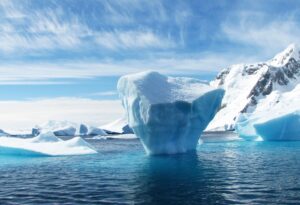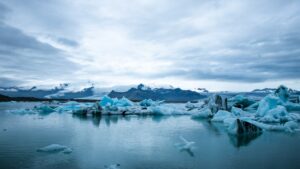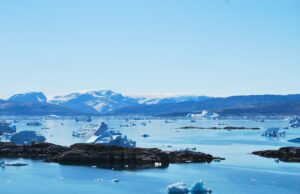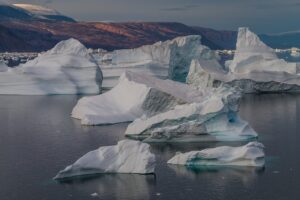Introduction
Glaciers are massive bodies of ice that form through the accumulation, compaction, and recrystallization of snow over extended periods of time. These frozen reservoirs of freshwater play a crucial role in shaping the Earth’s landscape and influencing its climate.
Formation of Glaciers
The formation of glaciers begins with snow accumulation in regions where more snow falls during the winter than melts during the summer. Over time, successive layers of snow compact under their own weight, gradually transforming into firn, a granular, compacted snow. As more layers accumulate and become denser, they undergo further.
Glaciers form through the accumulation, compaction, and recrystallization of snow over time. It begins with snowfall in cold environments, where subsequent layers of snow compress and turn into firn, a granular snow-like substance. Over time, the firn becomes more compacted and eventually transforms into glacial ice.
Factors such as temperature, snowfall rates, and topography influence glacier formation. Cold temperatures allow for the preservation of snow, while consistent snowfall adds layers to the glacier. The weight of overlying snow compacts the layers beneath, causing the transformation into firn and eventually glacial ice.

Types of Glaciers
Glaciers can be categorized into various types based on their size, location, and characteristics.
1. Mountain Glaciers:
Mountain glaciers, also known as alpine glaciers, are found in mountainous regions. They form in cirques (bowl-shaped hollows) at high altitudes, typically on the sides of mountains. Mountain glaciers are characterized by their flow down steep slopes and can be relatively small or extensive, covering entire mountain ranges.
2. Valley Glaciers:
Valley glaciers are a type of mountain glacier that flows down valleys, often carving and shaping the landscape as they move. These glaciers can be very long and wide, extending for many kilometers. Examples include the Aletsch Glacier in Switzerland and the Columbia Glacier in Alaska.
3. Piedmont Glaciers:
Piedmont glaciers are formed when valley glaciers spill out onto flatter plains or foothills, spreading into a wide fan shape. The Malaspina Glacier in Alaska is a classic example of a piedmont glacier.
4. Ice Caps:
Ice caps are smaller ice masses that cover less than 50,000 square kilometers. They are typically dome-shaped and often found in polar and subpolar regions. Greenland is an example of a landmass covered by an ice cap.
5. Ice Sheets:
Ice sheets are enormous expanses of glacial ice covering more than 50,000 square kilometers. Currently, the only existing ice sheets are in Antarctica and Greenland. These massive ice sheets play a significant role in the Earth’s climate and sea level regulation.
6. Outlet Glaciers:
Outlet glaciers are the tongues of ice that flow from the main ice sheet or ice cap into the ocean. They often end in floating ice shelves, which are important for controlling the flow of the glacier and stabilizing the ice sheet.

7. Tidewater Glaciers:
Tidewater glaciers flow into the ocean and terminate at the water’s edge. The face of these glaciers often breaks off to form icebergs, a process known as calving. Glacier Bay in Alaska is famous for its tidewater glaciers.
8. Cirque Glaciers:
Cirque glaciers are small, bowl-shaped glaciers found in cirques near mountain peaks. They often feed into larger valley glaciers.
9. Hanging Glaciers:
Hanging glaciers are glaciers that cling to the sides of mountains, often in a hanging position above valleys or slopes. They can be striking and dramatic features of mountain landscapes.
10. Rock Glaciers:
Rock glaciers are a mixture of rocks, debris, and ice. They move downslope, but their movement is mainly facilitated by the rock and debris within the ice.
Understanding the different types of glaciers is crucial for studying their behavior, impact on the environment, and potential contributions to sea level rise, especially in the context of ongoing climate change. Each type of glacier presents unique challenges and opportunities for scientific research and conservation efforts.
The Significance of Glaciers
Glaciers hold immense significance in our world, playing a crucial role in various aspects of the environment, climate, and human life. Here are the top five ways in which glaciers are of great importance.
1. Climate Regulation and Global Water Supply:
Glaciers act as natural reservoirs, storing vast amounts of freshwater in the form of ice. They release this stored water gradually, especially during dry periods, helping to sustain rivers and streams that millions of people rely on for drinking water, agriculture, and industrial use. Furthermore, glaciers contribute to climate regulation by reflecting a significant portion of the sun’s radiation, helping to cool the Earth’s surface and moderate global temperatures.

2. Sea Level Regulation:
Melting glaciers contribute to rising sea levels, which is a significant concern in the face of climate change. Understanding the dynamics of glacier melt and its impact on sea level rise is essential for coastal communities and ecosystems. Monitoring and studying glaciers helps in predicting future sea level changes and planning for the protection of vulnerable coastal regions.
3. Ecosystem and Biodiversity Support:
Glacier-fed rivers and lakes sustain unique ecosystems and habitats. These ecosystems support a wide array of plant and animal species, many of which are adapted to the cold, nutrient-rich waters originating from glacial melt. Changes in glacier dynamics and meltwater can disrupt these ecosystems, affecting the biodiversity and balance of fragile environments.
4. Tourism and Cultural Importance:
Glaciers are natural attractions that draw millions of tourists each year. People visit these frozen landscapes for their breathtaking beauty and to experience activities such as glacier hiking, skiing, and mountaineering. Glaciers are also culturally significant to indigenous communities, often holding spiritual or traditional value. The loss of glaciers due to climate change impacts both tourism and cultural heritage.
5. Scientific Research and Climate Change Indicators:
Glaciers serve as important indicators of climate change. Monitoring changes in glacier size, movement, and volume provides vital data for understanding climate patterns and predicting future environmental shifts. Scientists study glaciers to grasp the impacts of climate change and formulate strategies for mitigating its effects. Glacial ice cores, which preserve historical climatic information, are crucial tools for researching past climates and predicting future climate trends.
Glacier Effects on Ecosystems
Glaciers play a vital role in ecosystems, and their changes can impact the environment significantly. Here are five ways glaciers affect ecosystems.
1. Water Source:
Glaciers act as natural reservoirs, providing a steady source of freshwater to downstream ecosystems and supporting aquatic life.
2. Habitat Alteration:
Glacier retreat can alter the physical landscape, affecting habitats for various plants, animals, and microorganisms that depend on specific conditions.
3. Albedo Effect:
The reflectivity of glaciers, known as albedo, affects temperature. As glaciers melt, they expose darker surfaces, absorbing more heat and contributing to further warming.

What is the Hurricane: When, Where and Why They Occur
4. Nutrient Supply:
Glacial meltwater transports nutrients, minerals, and organic matter, enriching downstream soils and aquatic ecosystems, influencing plant growth and overall biodiversity.
5. Sea Level Rise:
Glacier melt contributes to rising sea levels, impacting coastal and marine ecosystems, affecting coastal habitats, wildlife, and the communities that rely on them.



















[…] Glaciers: Formation, Significance, Effects on Ecosystems and Types of Glaciers […]
Excellent website with a wealth of useful information; I’m forwarding it to some friends and also sharing it on Delicious. Obviously, I appreciate your effort.
I do not even know how I ended up here but I thought this post was great I do not know who you are but certainly youre going to a famous blogger if you are not already Cheers
I do agree with all the ideas you have introduced on your post They are very convincing and will definitely work Still the posts are very short for newbies May just you please prolong them a little from subsequent time Thank you for the post
I loved as much as you will receive carried out right here The sketch is tasteful your authored subject matter stylish nonetheless you command get got an edginess over that you wish be delivering the following unwell unquestionably come further formerly again as exactly the same nearly very often inside case you shield this hike
you are in reality a good webmaster The website loading velocity is amazing It sort of feels that youre doing any distinctive trick Also The contents are masterwork you have done a fantastic job in this topic
you are in reality a just right webmaster The site loading velocity is incredible It seems that you are doing any unique trick In addition The contents are masterwork you have performed a wonderful task on this topic
helloI like your writing very so much proportion we keep up a correspondence extra approximately your post on AOL I need an expert in this space to unravel my problem May be that is you Taking a look forward to see you
Thanks I have recently been looking for info about this subject for a while and yours is the greatest I have discovered so far However what in regards to the bottom line Are you certain in regards to the supply
Usually I do not read article on blogs however I would like to say that this writeup very compelled me to take a look at and do so Your writing taste has been amazed me Thanks quite nice post